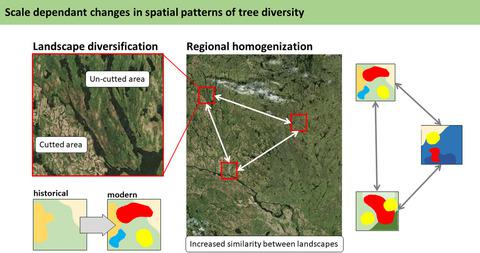Our official English website, www.x-mol.net, welcomes your feedback! (Note: you will need to create a separate account there.)
Scale‐dependent changes in tree diversity over more than a century in eastern Canada: Landscape diversification and regional homogenization
Journal of Ecology ( IF 5.5 ) Pub Date : 2020-07-13 , DOI: 10.1111/1365-2745.13474 Victor Danneyrolles 1, 2, 3 , Mark Vellend 3, 4 , Sébastien Dupuis 1 , Yan Boucher 3, 5 , Jason Laflamme 3, 6 , Yves Bergeron 2, 3 , Gabriel Fortin 1 , Marie Leroyer 1 , André Römer 1 , Raphaële Terrail 1 , Dominique Arseneault 1, 3
中文翻译:

加拿大东部一个多世纪以来树木多样性的尺度变化:景观多样化和区域同质化
更新日期:2020-07-13
Journal of Ecology ( IF 5.5 ) Pub Date : 2020-07-13 , DOI: 10.1111/1365-2745.13474 Victor Danneyrolles 1, 2, 3 , Mark Vellend 3, 4 , Sébastien Dupuis 1 , Yan Boucher 3, 5 , Jason Laflamme 3, 6 , Yves Bergeron 2, 3 , Gabriel Fortin 1 , Marie Leroyer 1 , André Römer 1 , Raphaële Terrail 1 , Dominique Arseneault 1, 3
Affiliation

|
- A better understanding of how disturbance impacts tree diversity at different scales is essential for our ability to conserve and manage forest ecosystems in the context of global changes. Here we test the impacts of land use‐related disturbances on tree diversity since the 19th century across a broad region (>150,000 km2) of northern temperate forests in eastern Canada.
- We used a large and unique dataset of early land surveys conducted during the 19th century (>130,000 species lists), along with modern forest inventories (>80,000 plots), to analyse long‐term changes in taxonomic and functional tree diversity at several scales (grid cell resolutions ranging from 12.5 to 1,600 km2; we refer to one grid cell as a ‘landscape’).
- Our results show that land use‐related disturbances have led simultaneously to (a) increased diversity within landscapes and a (b) homogenization at the regional scale (i.e. decreased composition dissimilarity among landscapes). These trends were found for both taxonomic diversity and functional diversity, with temporal changes more pronounced for taxonomic than functional diversity. We also found an increase over time in the strength of correlations between environmental variables and diversity both within and among landscapes.
- Synthesis. Our results support the idea that human‐induced impacts on biodiversity are strongly scale‐dependent and not necessarily associated with biodiversity loss. This highlights possible ways that human‐driven changes in tree diversity might impact forest resistance and resilience to future global changes.
中文翻译:

加拿大东部一个多世纪以来树木多样性的尺度变化:景观多样化和区域同质化
- 更好地了解干扰如何影响不同规模的树木多样性,对于我们在全球变化的背景下保护和管理森林生态系统的能力至关重要。在这里,我们测试了自19世纪以来加拿大东部北部温带森林的广阔区域(> 150,000 km 2)中与土地利用相关的干扰对树木多样性的影响。
- 我们使用了一个庞大而独特的19世纪早期土地调查数据集(> 130,000个物种清单),以及现代森林资源清查(> 80,000个地块),以在几个尺度上分析分类学和功能树多样性的长期变化(网格单元的分辨率范围为12.5至1600 km 2;我们将一个网格单元称为“景观”)。
- 我们的结果表明,与土地使用相关的干扰同时导致了(a)景观内多样性的增加和(b)区域范围内的同质化(即,景观间成分差异的减少)。对于分类学多样性和功能多样性都发现了这些趋势,与功能多样性相比,分类学的时间变化更为明显。我们还发现随着时间的推移,景观内部和景观之间的环境变量与多样性之间的相关强度会增加。
- 综合。我们的结果支持这样一个观点,即人为因素对生物多样性的影响在很大程度上取决于规模,而不一定与生物多样性的丧失有关。这突出了人为驱动的树木多样性变化可能影响森林抵抗力和对未来全球变化的适应力的可能方式。



























 京公网安备 11010802027423号
京公网安备 11010802027423号